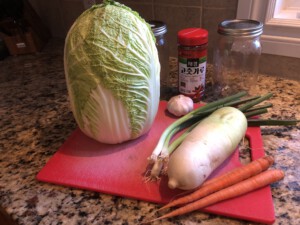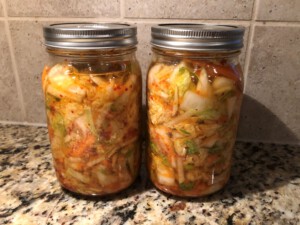In a large bowl, sprinkle and toss napa cabbage in kosher salt.
Pour distilled water over the napa cabbage until it covers all the napa cabbage and allow to stand for 1-2 hours. Napa cabbage will also soften at this time To keep the napa cabbage from floating, I placed a plate on top of the cabbage and another jar on top of the plate to weigh the plate down.
Save the brine water in the large bowl. Using tongs, transfer the napa cabbage into another large bowl. Set bowl of brine aside.
In the bowl of napa cabbage, add other vegetables – daikon, scallions, carrot and toss to combine. Set aside
In a small food processor, blend the spice paste by adding garlic cloves, white miso paste, grated ginger, gochugaru and sugar (if desired).
In the bowl of napa cabbage and vegetables, add spice paste. Using tongs or your hands (I recommend latex/nitrile gloves to prevent staining and the smell afterwards), toss the vegetables until the spice paste even coats the vegetables.
Transfer the spicy vegetables into 2 x 1 quart jars. Pack the vegetables down, this recipe fills both jars. Ensure the vegetables does not enter the stem of the jar, as you will need extra space for the fermentation process.
Pour the separated brine to fill the quart jars until vegetables are covered.
Cover the jars with the lid, but do not press or close the jar too tightly.
Set kimchi jars aside in a dark space at cool room temperature for 2 days. Bubbles will form inside the jar as gases form due to fermentation.
At each ~12 hour increment, open the jars in the kitchen sink and use a clean fork to press or poke down on the napa cabbage. This will release the gases that form with fermentation. Opening the jars in the sink catches any extra liquid that may spray out of the jar. Close the jar and allow to continue fermentation.
After 2 days, taste for tang. If you prefer more tang, allow to ferment up to 3 additional days in a dark space at room temperature. I like my kimchi fermented at 2-2.5 days.
Once kimchi is at your preferred tang, store in the fridge (ensuring the brine covers the vegetables) up to several months.
When serving, I use tongs or a fork to retain excess brine in the jar.


